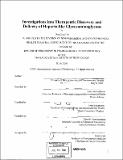Investigations into therapeutic discovery and delivery of heparin-like glycosaminoglycans
Author(s)
Liu, Dongfang, 1969-
DownloadFull printable version (7.532Mb)
Other Contributors
Massachusetts Institute of Technology. Division of Bioengineering and Environmental Health.
Advisor
Ram Sasisekharan.
Terms of use
Metadata
Show full item recordAbstract
Heparin-like glycosaminoglycans (HLGAGs) are complex polysaccharides found both in extracellular matrix (ECM) and at the cell surface where they, in a sequence-specific manner, bind to and regulate the biological activity of numerous proteins. Due to a lack of effective tools to study structure-function relationship of these complex molecules, the role(s) of HLGAGs in cancer remains largely indirect and poorly understood. To study the role(s) of HLGAGs in cancer growth, metastasis and angiogenesis, tumor systems were studied using heparinases I and III which have distinct substrate specificities. Studies, focusing on the biochemistry of the heparinase active site, elucidated key interactions important for enzymatic activities, thus enabling the biological studies presented here. In vitro cell culture study with heparinases as tools clearly showed that cell surface HLGAGs are involved in regulating fundamental cellular activities including cell proliferation, invasion and adhesion. Significantly, heparinase I and III demonstrated distinct effect on these cellular activities with heparinase III inhibiting tumor cell proliferation, invasion and adhesion in selected model systems and heparinase I inhibiting these processes. Further in vivo studies in animal tumor models confirmed and expanded the distinct responses to heparinase I and III treatment. HLGAG fragments generated from heparinase treatment were found to be responsible for the effect of heparinase treatment in tumor models. Moreover, cell surface HLGAGs containing cryptic activatory and inhibitory sequence information were identified and characterized. In contrast to heparinase I- generated HLGAG fragments, heparinase III- generated HLGAG fragments were shown here to inhibit both primary tumor growth and secondary lung metastasis. (cont.) The inhibition of tumor by heparinase III treatment was attributed to inhibition of specific signaling pathways such as FGF2 signaling. In an effort to develop a non-invasive and efficient delivery strategy for HLGAG-based therapeutics, HLGAGs were prepared as dry aerosol of defined characteristics for pulmonary inhalation. Pharmacokinetics study revealed efficient absorption for both formulated and unformulated dry aerosolized HLGAGs after pulmonary inhalation. Significantly, pulmonary inhalation of aerosolized HLGAGs was demonstrated to be effective in treating both local respiratory diseases including tumor metastasis and systemic thrombosis.
Description
Thesis (Ph. D. in Pharmacology and Toxicology)--Massachusetts Institute of Technology, Division of Bioengineering and Environmental Health, 2001. Includes bibliographical references (p. 131-153).
Date issued
2001Department
Massachusetts Institute of Technology. Division of Bioengineering and Environmental Health; Massachusetts Institute of Technology. Department of Biological EngineeringPublisher
Massachusetts Institute of Technology
Keywords
Division of Bioengineering and Environmental Health.